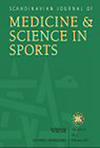在固定水平的感知努力下循环引起的神经肌肉疲劳:不同据称的缺氧方法的影响
IF 3.5
2区 医学
Q1 SPORT SCIENCES
引用次数: 0
摘要
我们比较了在常氧条件下(NOR)和三种所谓的缺氧模式下,在固定感知努力下骑车引起的神经肌肉疲劳:系统性缺氧(SyH, FiO2 = 0.13),血流限制(BFR, 50%动脉闭塞压)和气流限制面罩(ARM,校准至~3500 m)。17名健康的年轻参与者在创新的循环劳力计上以自主选择的功率输出(对应于艰苦的努力(15/20,博格等级)骑了20分钟,可以立即评估神经肌肉。在骑行前和骑行期间每5分钟测量一次膝关节伸肌的最大自主收缩(IMVC)、中枢(自主激活,VA)和周围疲劳。在整个循环过程中评估功率输出、外周氧饱和度(SpO2)、股四头肌氧合(近红外光谱,TSI)和疼痛。与NOR和ARM相比,BFR和SyH的功率输出较低,BFR的功率输出较SyH低。SpO2仅在SyH组降低(平均77%±4%)。在所有情况下,IMVC从第5分钟开始下降,随后趋于稳定(~ - 10%至- 20%),除了BFR,与其他情况相比,在VA降低和肌肉疼痛加剧的情况下,IMVC在第20分钟进一步下降至- 40%±14%。与其他情况相比,SyH组肌肉TSI进一步降低。我们的结果证实了ARM不能诱导缺氧。与其他情况相比,在股四头肌疼痛加重和肌肉缺氧不加重的情况下,BFR显示出更大的IMVC和VA降低。这些结果强调了股四头肌疼痛对最大和次最大运动输出的心理生理影响。本文章由计算机程序翻译,如有差异,请以英文原文为准。
Neuromuscular Fatigue Induced by Cycling at a Fixed Level of Perceived Effort: Effects of Different Purported Hypoxic Methods
We compared neuromuscular fatigue induced by cycling at a fixed perceived effort in normoxic condition (NOR) and three purported hypoxia modalities: systemic hypoxia (SyH, FiO2 = 0.13), blood flow restriction (BFR, 50% arterial occlusion pressure) and airflow restriction mask (ARM, calibrated to ~3500 m). Seventeen healthy young participants cycled for 20 min at a self‐selected power output corresponding to a hard effort (15/20, Borg scale) on an innovative cycle ergometer allowing immediate neuromuscular evaluation. Isometric maximum voluntary contraction of the knee extensors (IMVC), central (voluntary activation, VA) and peripheral fatigue were measured before and every 5 min during cycling. Power output, peripheral oxygen saturation (SpO2 ), quadriceps oxygenation (near‐infrared spectroscopy, TSI) and pain were assessed throughout cycling. Power output was lower in BFR and SyH compared to NOR and ARM and was lower in BFR compared to SyH. SpO2 was reduced only in SyH (mean 77% ± 4%). In all conditions, IMVC decreased from minute 5 and subsequently plateaued (~−10% to −20%), except in BFR, wherein it further declined to −40% ± 14% at minute 20 in the presence of lowered VA and exacerbated muscle pain compared to other conditions. Muscle TSI was further decreased in SyH compared to other conditions. Our results confirm the inability of ARM to induce hypoxia. Compared to other conditions, BFR showed a greater reduction in IMVC and VA, in the presence of a higher quadriceps pain and no greater muscle deoxygenation. These results underline the psychophysiological impact of quadriceps pain on both maximal and submaximal motor output.
求助全文
通过发布文献求助,成功后即可免费获取论文全文。
去求助
来源期刊
CiteScore
7.90
自引率
4.90%
发文量
162
审稿时长
3 months
期刊介绍:
The Scandinavian Journal of Medicine & Science in Sports is a multidisciplinary journal published 12 times per year under the auspices of the Scandinavian Foundation of Medicine and Science in Sports.
It aims to publish high quality and impactful articles in the fields of orthopaedics, rehabilitation and sports medicine, exercise physiology and biochemistry, biomechanics and motor control, health and disease relating to sport, exercise and physical activity, as well as on the social and behavioural aspects of sport and exercise.

 求助内容:
求助内容: 应助结果提醒方式:
应助结果提醒方式:


